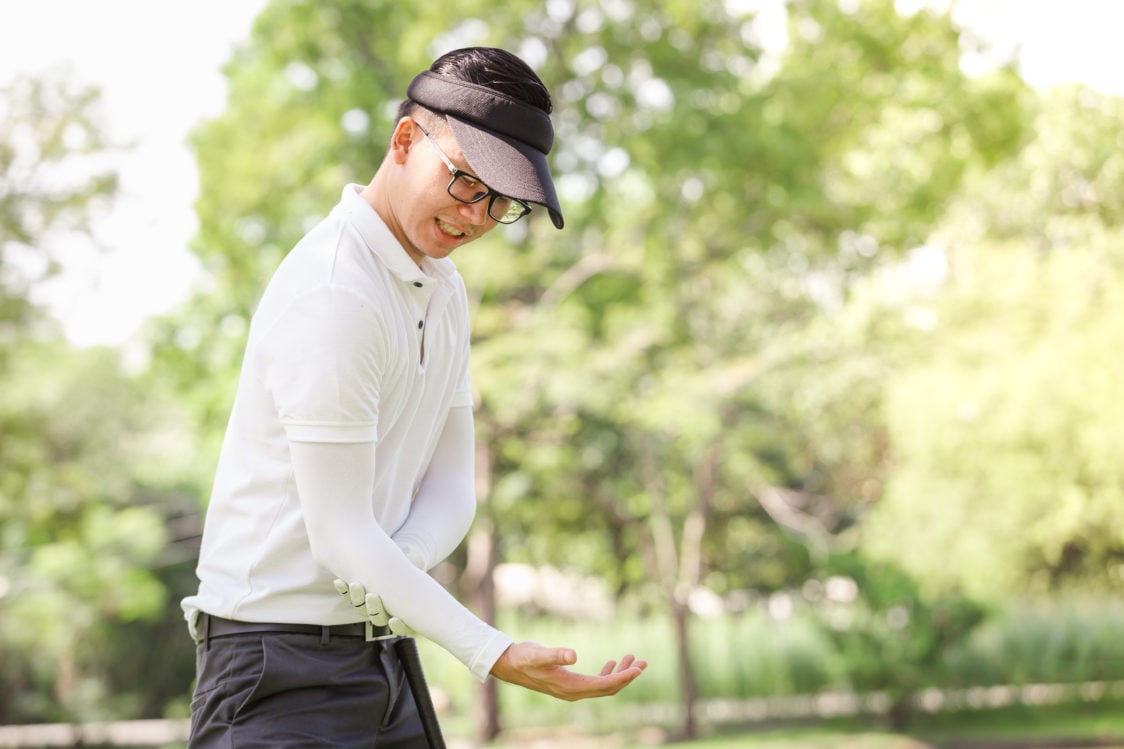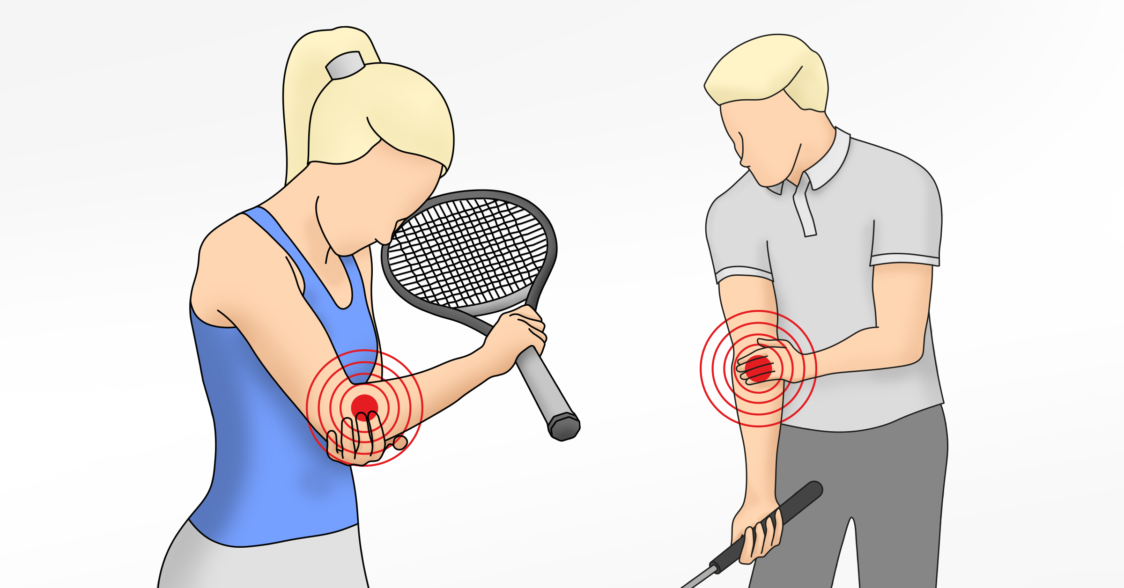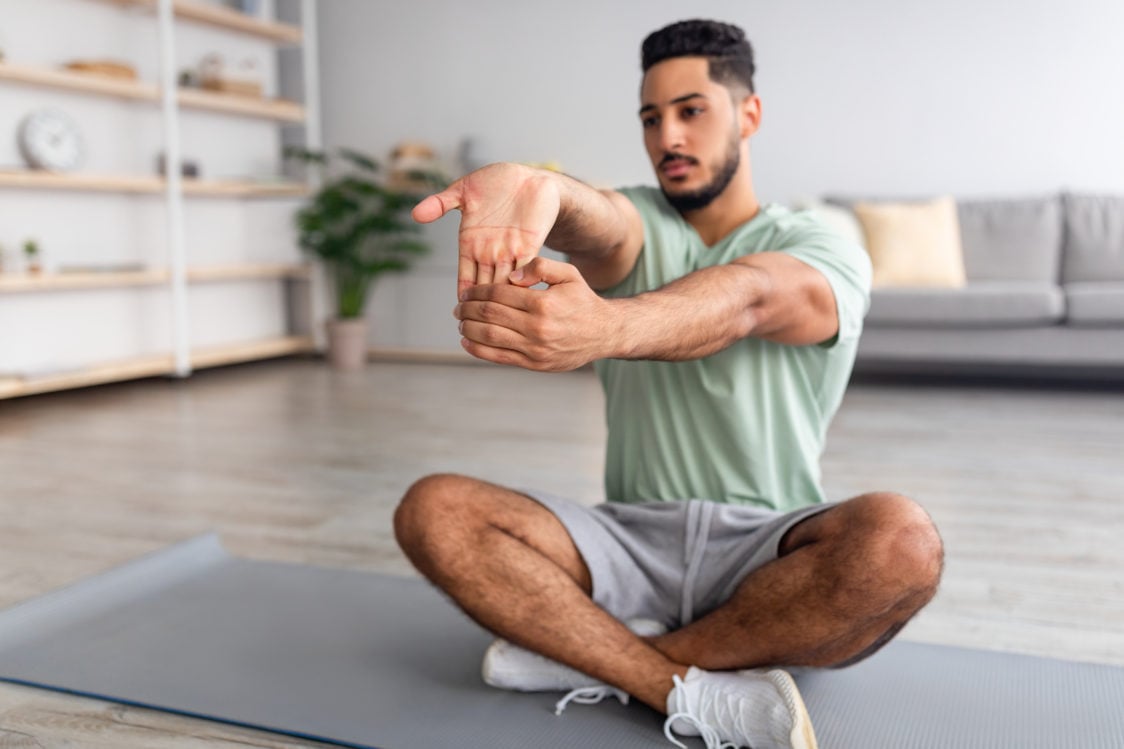Table of Contents
Have you ever had pain in your elbow? You might not have thought it could be tennis or golfer’s elbow, especially if you’re not a keen sportsman. These musculoskeletal disorders do not only affect active individuals, but also the non-sporting population. They are caused by unilateral stresses that occur at work, in sport, and even in everyday household activities. In today’s article, you will learn what is responsible for the development of tennis or golfer’s elbow and how best to prevent it.
What is tennis elbow?
Each of us imagines something different under the term tennis elbow. For example, when I was a kid, I associated it with an elbow swollen into the shape of a tennis ball. But the reality is a little different and less fun. It’s a condition that is technically called lateral epicondylitis. It causes disability and inflammatory changes in the tendons of the forearm, which attach the muscles to the bones. The elbow is particularly affected, where the muscles and tendons attach to the outer part of the humerus. [1-2]
What are the symptoms of tennis elbow?
- Pain, mainly felt on the outside of the elbow.
- Swelling can also be observed in this area.
- You may have a weakened grip.
- Pain intensity typically increases with exertion.
- It is most often caused by stretching, lifting or bending of the upper limb.
- Pain can also be felt when grasping and lifting objects.
- It also occurs during rotation of the forearm, which one commonly does, for example, when opening a jar or bottle of drink. [3]

What is golfer’s elbow?
Golfer’s elbow is sometimes referred to as javelin elbow, and in the medical dictionary you would find it under the term medial epicondylitis. It is an inflammatory condition of the tendons of the upper extremity that manifests itself as pain in the elbow and forearm. It most often arises from repeated use of the wrist and forearm to bend, grasp or twist things. Thus, it is easily confused with tennis elbow. In the case of golfer’s elbow, however, the inflammatory process occurs at the point of attachment, where the muscles and tendons attach to the central part of the humerus. Golfer’s elbow is less frequently encountered than tennis elbow. [4-5]
What are the symptoms of golfer’s elbow?
- The pain appears predominantly on the inside of the elbow.
- Sometimes in these areas you may observe swelling.
- You may have reduced sensitivity and tingling in the fingers.
- Weakness and stiffness of the entire affected limb is also common.
- Stronger pain can be felt when stretching and lifting the affected limb.
- Pain intensity typically also increases when grasping and lifting objects. [7, 14]

What is the difference between tennis elbow and golfer’s elbow?
Pain in the elbow area is a symptom specific to both of these conditions. If it is tennis elbow or golfer’s elbow, then the easiest way to tell is which side of the arm hurts more. As we have already noted above, in the case of tennis elbow one may feel the pain more severely on the outside of the elbow, while golfer’s elbow is mainly on the inside of the elbow. [6]
The difference is also found in the area of the damage to the muscles, which then manifests itself in their impaired function.
- In tennis elbow, the most commonly affected muscles are those you use to bend the wrist upwards towards the back of the hand (dorsiflexion) and extend the fingers. These muscles are primarily involved in tennis during the backhand stroke.
- In golfer’s elbow, the function of the muscles responsible for bending the wrist down to the palm (plantar flexion) and making a fist is negatively affected. These muscles are also involved in the forehand stroke, which is used by golfers as well as tennis players.
If you have difficulty with any of these movements, you can more easily recognize which of these musculoskeletal conditions might be affecting you. However, a reliable diagnosis is best made by a doctor (orthopaedic surgeon) or an experienced physiotherapist. [3, 7]

What are the most common causes of tennis and golfer’s elbow?
You probably know that naming these sports one after another is not exactly a coincidence. It is tennis or golf that are associated with the unilateral load that is typical for the development of this condition. But one can easily get tennis elbow from golf and vice versa. For both conditions, repetitive and unilateral movements lead to overloading of the muscles, tendons and ligaments in the upper limb. This starts to take its toll in the form of painful symptoms, which can appear in someone after the first week of a new training session, in another after several months of playing sport.
These problems are not only faced by tennis players and golfers. It has even been reported that in only 5% of people the cause of tennis elbow was playing tennis. In the case of professional athletes, this condition occurs even less frequently than in amateurs. As a rule, they have a comprehensive training plan that helps them prevent the effects of unilateral stress. [2]
This problem is more often encountered by recreational athletes, who usually do not focus so much on compensatory exercises. A diagnosis of tennis or golfer’s elbow could even be encountered by people who have never played these sports in their lives. It is enough to engage in jobs with unilateral movement or activities where you do the same movement over and over again with your hands. So even household chores such as cooking, cleaning, gardening, painting or chopping wood pose a higher risk.
Muscle injuries are more likely to occur during sporting activities. In case you are interested in first aid for a strained or torn muscle, read our article What to Do with a Strained or Torn Muscle and How to Tell Them Apart?
What are the risk groups for developing tennis and golfer’s elbow?
- tennis, table tennis, badminton and squash players
- archers, golfers, javelin throwers, cricketers
- people who work on computers
- weightlifters, powerlifters and other strength athletes
- musicians
- tradesmen (plumbers, carpenters, car mechanics)
- butchers, chefs and bakers. [8]
You might be interested in these products:
Treatment of tennis and golfer’s elbow
If you have been experiencing pain in your elbow for several days and it gets worse when you move, it is possible that it is tennis or golfer’s elbow. In such a situation, it is advisable to see a doctor (orthopaedic surgeon). They will then make a diagnosis, determine the extent of the impairment and suggest a tailored treatment plan. Common components include the use of anti-inflammatory drugs, ultrasound or laser therapy, rehabilitation exercises under the supervision of a physiotherapist and other orthopaedic methods. Only if these methods do not work one should consider surgery. [6, 9-10]
How long does tennis and golfer’s elbow take to heal?
The treatment time may be a little different for each person. It always depends on the type and degree of musculoskeletal damage. In most cases, however, it takes 6 months to 2 years. Some people get both tennis and golfer’s elbow back over the course of their lives. For this reason, preventative measures are important. [4]
How to prevent tennis and golfer’s elbow?
The development of these conditions is most often due to a certain area of a lifestyle. Typically, this relates to employment, sporting activities or household chores, which we have listed above. For groups at risk, preventive measures become a necessity. However, it is also true for all people who are trying to promote their health in a balanced way.
1. Strengthen your wrist and forearm muscles
During everyday activities such as typing on the computer, washing windows, painting, you regularly work out your wrists. The following exercises are also suitable during the day or before a workout. They help improve the flexibility (mobility) of the muscles, tendons and ligaments in the hand, which in turn reduces the risk of injury. [11]
Exercises to work out and stretch the wrists
1. Wrist circles
In a seated or standing position, face forward and start making circles with your wrists. First one side, then the other. Aim for maximum range of motion. Do at least 10 circles on each side in 3 sets.
2. Kneeling wrist stretch
Get on your knees so that you are on all fours with palms on the mat, fingers pointing away from your body. Bring your palms together on the mat so that the insides of your wrists are touching. They should be positioned approximately under your chest. The arms remain extended. Then, with your torso, to lean forward, sideways and backward in a clockwise direction, and you should feel a stretch in your wrists and forearms. The more you lean, the more intense the stretch should be. Change direction after 5 repetitions. Do this for 3 sets on each side.
3. Kneeling wrist extension with palms upwards
Stay down on all fours. Turn your palms upwards with your fingers pointing towards your knees this time. Keep your elbows extended and try to keep the back of your hand on the mat. You should already feel the stretch in this position. Increase this again by moving backwards, slowly landing on your heels. In this position, hold for 20-30 seconds. Then return to the starting position and repeat this exercise 2 more times.
4. Seated wrist stretch
Sit on a chair or mat and extend one arm. Twist it so that the inside of your elbow is facing up, palm away from you and fingers down. Then, using your other hand, lightly press your fingers in the direction of your body (towards the back of your hand). This will give you a more intense stretch. Hold for at least 20-30 seconds, and then release your hand. Repeat the exercise 3 times on both hands. You can then bend the wrist to the other side (fingers pointing upwards) with the same duration and number of repetitions.

2. Strengthen forearm muscles
Forearm exercises will help you to strengthen and tone the muscles of the hand, which will be more resistant and will be able to handle heavier loads more easily. Another benefit of these exercises is a stronger grip, which will be appreciated even during normal weight training (push-ups, deadlifts). Always include dynamic wrist and forearm stretching before exercise. Perform the following exercises 2-3 times a week as a supplement to full body strength training to prevent injuries. [12-13]
Exercises to strengthen wrists and forearms
1. Forearm curls with dumbbells
Sit on a weight bench, grab lightweight dumbbells. Place the backs of your hands on the bottom of your thighs (palms facing up) and lift the dumbbells towards you with a wrist movement. You can then rotate your hands (palms facing down) and bend your wrists towards you again. Perform 8-12 reps on each arm for 3 sets.
2. Bar hang
Hang on the bar with your hands above your head, relax the rest of your body and stay in this position for 20-60 seconds. Then repeat 2 more times.
3. Farmers Carry
Use both hands to grasp the dumbbells or kettlebells (ideally heavier than you normally use). Firm your core, keep your shoulders pulled away from your ears and take a few steps forward. Then return and continue walking until you are able to keep the weight and your back straight and engage your core. Next, put the weights down, pause (30-60 seconds) and repeat the exercise 2 more times.
4. Squeezing grip ring
By regularly squeezing the grip ring you will strengthen the muscles of your fingers, palm, wrist and forearm. You can even take it to work and exercise with it during the day. It’s also great as an anti-stress tool.

3. Measures to take whilst at work and during your leisure time
If the movement you do at work is causing you problems, you can discuss the possibilities of changing your work duties with your employer. However, if the nature of your job does not allow it, you can at least try to include short breaks to stretch your wrists and forearms. Strengthening the whole body will then help you to compensate for the unilateral load. When working on the computer, you can also try an ergonomic keyboard and mouse, which keep your wrists and forearms in a more natural position. [7, 14]
The same rules apply to housework. If you have to paint the whole apartment, chop wood or work in the garden all day, you should also include breaks to stretch or find a buddy to take turns with. You should also try to change your body position during these activities. [7, 14]
If you spend your leisure time actively, you should be careful of unilateral overloading of the upper limb. This is doubly true for people who have just started playing tennis, squash, badminton or golf. Always warm up and stretch before training. Place a lot of emphasis on proper technique and gradually increase the time spent on a new sport.
What should you remember?
Anyone can experience pain in the elbow during their lifetime. Depending on whether you have more pain on the outside or inside of the elbow, you can tell if it is tennis elbow or golfer’s elbow. There are several causes of these musculoskeletal disorders. However, their common feature is unilateral stress. This is best compensated for by regular stretching and strengthening of the wrists and forearms. Comprehensive strength training, a sensibly set training plan or short breaks at work also work as preventive measures that can protect you from developing tennis and golfer’s elbow.
Do you have someone in your circle of friends who engages in unilateral physical activities or often complains of elbow pain? Share this article with them and help them prevent these problems.
[1] Nhs.Uk. Tennis elbow. – https://www.nhs.uk/conditions/tennis-elbow/
[2] Physiopedia. Lateral Epicondylitis. – https://www.physio-pedia.com/Lateral_Epicondylitis
[3] Tennis Elbow vs. Golfer’s Elbow—What’s the Difference? – https://handsurgical.com/tennis-elbow-vs-golfers-elbow/
[4] NHS Lanarkshire. Golfer’s Elbow. [https://www.nhslanarkshire.scot.nhs.uk/services/physiotherapy-msk/golfers-elbow/
[5] Cleveland Clinic. Golfer’s Elbow (Medial Epicondylitis): What Is It, Diagnosis & Treatment. – https://my.clevelandclinic.org/health/diseases/21711-golfers-elbow-medial-epicondylitis
[6] Golfer’s Elbow and Tennis Elbow Differences—Austin, TX Joint Pain and Tendinitis. – https://www.orthoaustin.com/blog/2018/02/14/golfer-s-elbow-vs-tennis-elbow-189405
[7] Tennis Elbow vs. Golfer’s Elbow—What’s the Difference? – https://www.oip.com/tennis-elbow-vs-golfers-elbow-explained/
[8] JointFlex. Causes of Tennis Elbow and Other Athletes Also at Risk. – https://jointflex.com/tennis-elbow-athletes-at-risk/
[9] Institute for Quality and Efficiency in Health Care (IQWiG). The treatment options for tennis elbow and golfer’s elbow. – https://www.ncbi.nlm.nih.gov/books/NBK507001/
[10] How Long Does Tennis Elbow Take To Heal? – https://tenniselbowclassroom.com/treatments/how-long-to-heal-tennis-elbow/
[11] Bodytonic Clinic. Tennis and golfer’s elbow. – https://bodytonicclinic.co.uk/tennis-and-golfers-elbow/
[12] Grillo, J. How To Prevent, Identify, and Treat Golfer’s Elbow. – https://rothmanortho.com/stories/blog/golfers-elbow
[13] Lifemark. What is golfer’s elbow and how to prevent it. – https://www.lifemark.ca/blog-post/what-golfers-elbow-and-how-prevent-it
[14] Mayo Clinic. Golfer’s elbow—Symptoms and causes. – https://www.mayoclinic.org/diseases-conditions/golfers-elbow/symptoms-causes/syc-20372868

